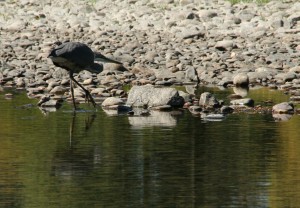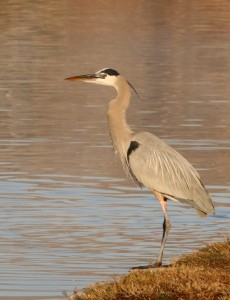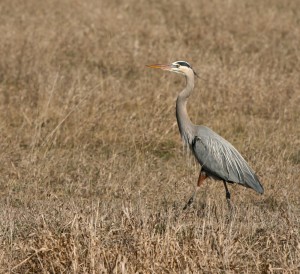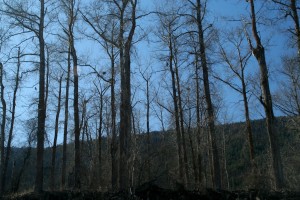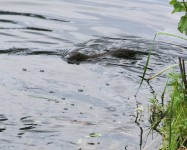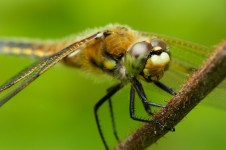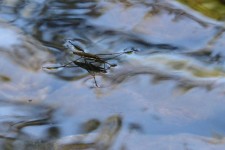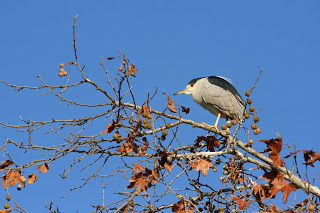Standing motionless in stagnant water, a great blue heron’s head suddenly reels forward into the water and emerges with a small fish. Great blue herons are known for being excellent fishers. Their stealth and lightning-fast strike enable them to sneak up on prey.
Several features help herons forage effectively. Their long legs enable them to wade into deeper water than other shoreline birds. They can stand still for long periods of time waiting for a fish to come into range or walk very slowly to stalk prey.
When a fish is within range, their S-shaped neck allows them to quickly strike prey. Specially-shaped vertebrae allow herons to curl their neck in preparation to strike or while in flight (a helpful identification characteristic).
Depending on the size of the fish, the heron strikes in one of two ways. For small fish, herons grab the fish between the mandibles of its bill. For large fish, herons stab the fish with their sharp bill. They then shake the fish to break or relax the sharp spines before gulping down the fish whole.
Despite their narrow-looking neck, herons can swallow large fish. Since they swallow fish whole, herons regurgitate the solid waste (bones, scales) in the form of pellets similar to how owls regurgitate pellets.
Another adaptation for eating fish is the special feathers on their chest to help clean fish before they eat them. Herons rake the powder down feathers with their feet to shake off a powder that causes fish slime and oil to clump. This enables the heron to brush off the clumps with its foot before eating it. Herons also rub this powder on their belly feathers to repel swamp slime.
Even though herons are known as excellent fishers, their diet is highly variable. They also feed on frogs, salamanders, snakes, small birds, small mammals, crayfish, dragonflies and grasshoppers. One study in Idaho found that voles comprised 24 to 40 percent of a heron’s diet. Voles are a major potion of a heron’s winter diet because the shallow, calm water they feed in is often frozen.
Their variable diet is one reason the great blue heron is the most widespread heron in North America. In some areas the heron resides year-round but in northern areas herons migrate south unless there is a reliable food source.
Whether they are permanent residents or migrants, great blue herons are noticeable in the spring when they are nesting because of their noisy ruckus. Herons are solitary when they hunt but they nest in colonies. The heronries can include up to 500 nests in areas with plentiful food and nesting sites but typically range from a few to several dozen nests.
Herons build their nests high in trees if trees are available otherwise they build them among grass on islands. In Idaho and Montana, herons favor cottonwood trees along rivers and lakes but they will also nest in the tops of ponderosa pine and willows.
They build large, stick platform nests with the male bringing material and the female placing the items. Herons will often reuse nests and the oldest nests are the largest–sometimes up to four feet across.
Like most animals, herons are most vulnerable when young with 69 percent dying before they are a year old. Eagles, raccoons, bears, turkey vultures and red-tailed hawks are a few predators of great blue heron young. If a chick or an adult is killed within a nesting colony the other birds will often abandon the colony.
Once the young fledge, they return to the nest to be fed for up to three weeks, placing great demand on their parents’ fishing skills.

